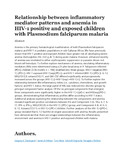Relationship between inflammatory mediator patterns and anemia in HIV-1 positive and exposed children with Plasmodium falciparum malaria
Date
2012-05-08Author
Davenport, Gregory C
Hittner, James B
Were, Tom
Ong'echa, John M
Perkins, Douglas J
Metadata
Show full item recordAbstract
Anemia is the primary hematological manifestation of both Plasmodium falciparum malaria and HIV-1 in pediatric populations in sub-Saharan Africa. We have previously shown that HIV-1 positive and exposed children have greater risk of developing severe anemia (hemoglobin, Hb <6.0 g dL⁻¹) during acute malaria. However, enhanced severity of anemia was unrelated to either erythropoietic suppression or parasite-driven red blood cell hemolysis. To further explore mechanisms of anemia, circulating inflammatory mediators (IMs) were determined using a 25-plex bead array in P. falciparum-infected (Pf[+]) children (3-36 month, n = 194) stratified into three groups: HIV-1 negative (HIV-1[-]/Pf[+]); HIV-1 exposed (HIV-1[exp]/Pf[+]); and HIV-1 infected (HIV-1[+]/Pf[+]). IL-12, MIG/CXCL9, eotaxin/CCL11, and GM-CSF differed significantly and progressively increased across the groups (HIV-1[-]→HIV-1[exp]→HIV-1[+]). To further explore the relationship between the inflammatory milieu (i.e., cytokines, chemokines, and growth factors) and HIV-1 status, the large panel of IMs was reduced into discrete groups by principal component factor analysis. Of the six principal components that emerged, three components were significantly higher in the HIV-1 [+]/pf[+] and HIV[exp]/Pf[+] groups, demonstrating that inflammatory profiles differ according to HIV-1 status. Additional analyses exploring the relationship between the components and anemia revealed significant positive correlations between Hb and Component 3 (IL-1Ra, IL-7, IL-17, IFN-α, IFN-γ, MIG/CXCL9) in the HIV-1[-]/Pf[+] group, and Component 4 (IL-4, IL-5, IL-12, Eotaxin/CCL11) in HIV-1[+]/Pf[+] children. Further analyses of the HIV-1[+]/Pf[+] group revealed that IL-12 had the strongest association with anemia. Results presented here demonstrate that there are unique relationships between the inflammatory environment and anemia in HIV-1 positive and exposed children with malaria.
URI
https://doi.org/10.1002/ajh.23200https://pubmed.ncbi.nlm.nih.gov/22570198/
http://r-library.mmust.ac.ke/123456789/1539
Collections
- Gold Collection [989]

